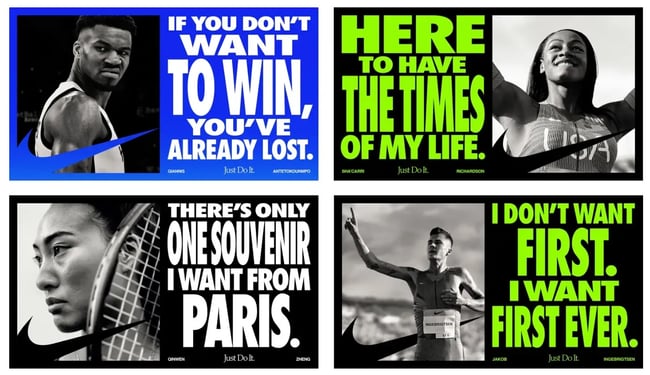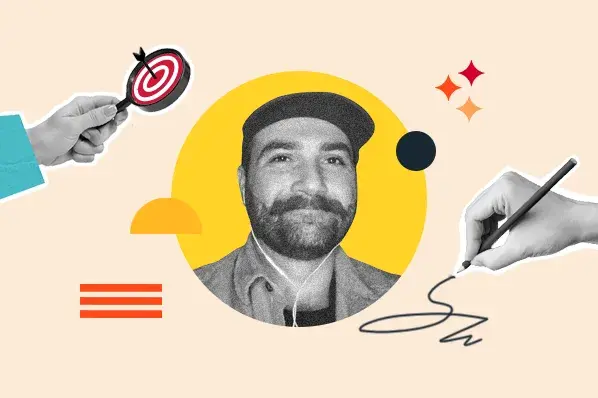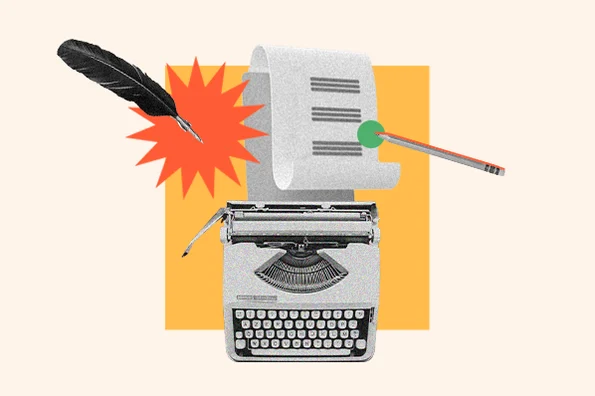And people responded. One person even apologized for not logging in for a few days. That message made me proud. Honestly, it moved me a little. The CEO was happy too, because user engagement increased, which eventually led to more paid sign-ups.
That experience reminded me how even “a little bit of writing” can have a big, measurable impact on a business. Of course, adding emotion is just one tactic. What works best depends on where the copy appears, whether it’s on a billboard, a website, or a product label.
Below, I’ve put together 15 traits that, in my view, make for truly great copy along with examples to show how and why they work.
Table of Contents
Copywriting is an art, and I truly mean that. It’s so much more than just crafting words that sell.
Great copy motivates people to take action, builds genuine connections by stirring emotions, and helps brands stand out — even when their product doesn’t.
Copywriting is also challenging. Unlike writing an article, you only have a few words to make your case. So what makes for good copy? It’s not just about being short and sweet. There’s a lot more to it than that.
15 Traits of Good Copywriting
1. It shifts your perspective.
A subtle shift in perspective can make all the difference. Great copy often breaks through not with volume, but with a surprising angle that catches the reader off guard (in a good way). Every story has multiple entry points; the copywriter’s job is to uncover the one that hits home.
Milda Bernataviciute, senior content marketing manager at Omnisend, highlights how strong copy can disarm readers by addressing unspoken objections in a tone that feels real.
She points to Omnisend’s AI landing page as an example. The headline reads, “Oh no. AI’s taking my job,” with a sticky note below that casually responds, “FINALLY!”

This contrast works, Milda explains, because it acknowledges a real fear — AI replacing marketers, but immediately flips it with humor and relief. The copy that follows reinforces the message by reframing AI as a helpful tool that takes over tedious tasks.
“By addressing an emotional objection up front, we build trust,” she says. “And by keeping the tone light, we connect with the audience on a personal level.”
2. It finds connections.
Back in 1996, Steve Jobs said something that still rings true about human creativity almost three decades later. In a Wired Magazine interview, he explained:
“Creativity is just connecting things. When you ask creative people how they did something they feel a little guilty because they didn’t really do it, they just saw something. It seemed obvious to them after a while.”
That “something” is often the connection between a company’s product, service, or even brand personality and a part of life that people instinctively relate to. Very often, it’s not really about the product itself. It’s about how it makes you feel.
One of the best examples I’ve seen lately comes from none other than Nike. For their 2024 Paris Olympics campaign, they went bold with the line: “Winning isn’t for everyone.”
I think it’s genius because it stops you in your tracks and makes you ask yourself — am I the kind of person who really wants to win? Or even more uncomfortably, does wanting it this badly make me a bad person? That exact question is even voiced by the athletes in the ad.
What makes it powerful is the emotional connection it draws. These elite athletes may live and breathe competition, but the feeling they express — the obsession to improve, to prove something, and to keep pushing — is universal. Whether it’s about chasing a podium, a promotion, or a personal goal, the desire is the same.

I also agree with Marketing Dive reporter Peter Adams that this was a comeback moment in classic Nike style, after a few years of decreased sales during the pandemic.
3. It has a good lead.
Volkswagen’s Life Half-Full campaign for the ID Buzz is a masterclass in setting the tone early. Created by Johannes Leonardo, the campaign taps into the free-spirited, fun-loving energy that Volkswagen sees in its drivers. In a world where life often feels rushed and overbooked, Life Half-Full offers a refreshing invitation. They’re telling you to slow down, enjoy the ride, and find joy in the everyday.
With its retro-inspired two-tone design and electric engine, the ID Buzz isn’t just a reboot of the iconic VW bus, it’s a symbol of optimism. As Jonathan from the campaign team put it, “It’s a celebration of optimism, an anthem for people who know how to find fun in the everyday. So, we invited America to see life half-full, to welcome a pop of color on its roads again.”
Rather than leading with specs or performance metrics, the campaign leads with feeling. By positioning the vehicle as “a source of joy in everyday life,” it connects instantly on an emotional level. Strong leads do more than inform — they set the stage. And this one invites people to feel something before they even hear what the product can do.
4. It is born out of listening.
Back in 2019, when I was working as a content marketer at a customer feedback company, much of my work revolved around the voice of the customer. Even then, it was clear that good copy tapped into what customers cared about — whether it was their goals, needs, or favorite features.
But I think it wasn’t until TikTok took off that we really started to see just how much inspiration brands could draw from their audiences. It gives marketers a front-row seat to how people talk, what they care about, and what makes them engage.
CeraVe is one brand that has really made the most of this opportunity. They started analyzing what their target clients were posting online, and found out that they craved accessible, trustworthy, and engaging information. That said, while they were seeking dermatological advice, they also wanted to receive it in a format that was entertaining and relatable.
This led CeraVe to develop what they call “medutainment,” which is a fusion of medical education and entertainment.
I believe they are doing a great job at adjusting the seriousness of their tone of voice to the medium and subject they discuss. While their website has a more universal statement, “CERAVE IS DEVELOPED WITH DERMATOLOGISTS,” their online and TV campaigns tend to be more playful.
For example, for Super Bowl LVIII, they partnered up with actor Michael Cera, who playfully implied that he may or may not have been the founder of the brand. This was followed by the tagline “Developed with dermatologists. Not Michael Cera.”
L’Oreal, who own the CeraVe brand, largely credits the $2B brand valuation to these types of customer-driven initiatives.
I think this nicely links with what Copyblogger’s Robert Bruce has said in an older blog post. “Humble yourself and truly serve your audience, listen to their needs and desires, listen to the language they use (...) If you listen carefully, your audience can eventually give you everything you need.”
5. It avoids jargon and hyperbole.
Disruptive. Next-gen. Seamless integrations. World-class technology.
Are you still with me?
These are all examples of filler terms or buzzwords that some copywriters use, particularly when they’re writing copy for digital products. While they seem reassuring at first (after all, who wouldn’t want to use a “next-gen” solution?), they don’t convey any information value.
Some brands, however, refrain from using them — much to their advantage.
Take Dropbox Dash for one. The core message on the homepage, i.e., “Find anything. Protect everything” relates to two main jobs that their users want to get done — easy access to their data stored in the cloud, and data safety. Notice how the copy lacks these filler words or tech jargon, leaving the details about the specific technicalities for their dedicated Features and Product Pages.

6. It knows its audience.

Create personas with HubSpot's template
Great copy starts with truly knowing who you’re speaking to. I can tell you from personal experience that some of my best landing page copy work results from having access to detailed customer profile information — like their struggles, objectives, and what drives them in decision-making.
When I have that information, I’m able to write each piece of copy with strong intent and understanding. It’s truly about meeting people where they are and speaking their language.
7. It uses compelling messaging.
Some pieces of copy are designed to tell a story, build trust, or create an emotional connection. Others are built with a clear goal in mind, like to prompt action. One of my favorite recent examples of the latter comes from Basecamp.
On their homepage, right before the FAQs, they use the line:

It’s a direct acknowledgment of why someone has made it all the way down the page. Placing this message as the last H2 is smart because it targets visitors who’ve shown real interest by scrolling through the entire page.
It’s like Basecamp is saying, “Listen, we’ve got you. You’re here because your current methods aren’t cutting it, and we have the solution.”
This kind of copy can be both motivating and highly relevant.
8. It’s research-driven.
Strong copy doesn’t just rely on assumptions — it draws on real data and research to understand the audience’s challenges and priorities.
Here’s an example of a page that I’ve co-created with The Software House, dedicated to the company’s Specialists on Demand service. Notice how early on, we’ve decided to mention specific statistics that tie in with key pain points for tech teams:

I had to peruse tons of IT reports to find them, but I believe they do a great job of shortening the distance between the company and its potential clients.
These hard numbers in the copy prove that The Software House knows the frustrations their prospects face daily. Plus, it shows that the brand isn’t guessing what matters — they’ve done their homework, and they’re addressing exactly what keeps their audience up at night.
I believe that this trait is particularly suitable for brands that operate in B2B, where the products or solutions often require a larger budget (and buy-in from multiple stakeholders).
9. It flows naturally.
Good copy doesn’t make you work. It pulls you in, line by line, with zero friction. The rhythm feels smooth, the structure makes sense, and you’re never stuck rereading a sentence to figure out what it means. If someone has to read your copy twice to understand what you meant, you’ve failed.
Natural flow comes from sharp writing — using imaginative language, clean transitions, and just enough momentum to keep the reader moving. No clunky phrasing or awkward jumps, just clarity and control.
When copy flows, the message becomes easier to absorb and harder to ignore. It builds trust without the reader even realizing it. They’re not thinking about how it’s written; they’re just getting it.
10. It has a strong voice.
I believe voice is everything in copy. It’s what makes a message unmistakably yours. A strong voice isn’t just about tone. It’s about identity. It reflects what a brand stands for, how it speaks, and what it believes. And in a world of endless content, that kind of clarity and confidence is what cuts through the noise.
Rebecca Hopwood, founder and marketing director at Youbee Media, puts it perfectly when describing Nike’s So Win campaign. To her, it’s “a masterclass in emotionally charged copywriting,” where every word carries weight and purpose.
The campaign uses bold, declarative statements and tight line breaks to build what she calls “a rhythmic, almost spoken-word energy that feels like both protest and poetry.”
“Lines like ‘do it anyway — and redefine the expectations of sport along the way’ speak to me in a way that a lot of marketing campaigns don’t these days,” she says. “This isn’t just messaging — it’s movement.”
She compares the pacing to America Ferrera’s monologue in Barbie, where each short line lands like a drumbeat, creating momentum and belief. “For me, the copy feels like action in itself,” Hopwood says. “It invites not just understanding, but participation.”
And that’s what a strong voice does. It makes a brand not only heard, but felt.
11. It leverages AI tools.

Get started with HubSpot's Content Assistant
AI tools like HubSpot’s Content Assistant help refine copy by offering instant feedback on grammar, structure, and readability. They highlight areas for improvement and suggest better word choices to strengthen the overall message.
HubSpot also offers a Blog Ideas Generator, which helps generate relevant topics and titles based on common audience pain points. This makes it easier to overcome writer’s block and start the content creation process with focus.
In addition, these tools can suggest keywords and ensure the copy follows SEO best practices, increasing its chances of ranking well in search results.
Using AI in the writing process saves time, improves content quality, and helps copywriters create messages that are both polished and effective.
12. It is creative.
Who doesn’t love creative copy? I know I do, and few brands pull it off like Netflix. There’s a spot right in the center of Warsaw where they place banners for every big show launch. And every time I see one, I think, “Wow, this is so good. How did they come up with that?”
Take their campaign for The Witcher, promoted in Warsaw. It’s clever, bold, and totally attention-grabbing — it reads, “The gossip says, the Witcher is back.”

Or the one from Sunset Boulevard:

Their copy is often just as engaging as their TV series (well, most of them). It’s the kind of writing that makes you look forward to the next ad as much as the next season. For me, that’s the magic of creative copy. It sticks with you. And it makes you like the brand a little more.
13. It cuts out excess.
Good writing is punchy. Too many words can confuse the reader, or worse, bore them. I’ve found that with attention spans getting shorter, it’s crucial to get to the point as quickly as possible.
What works for me is writing a draft first, then tightening it. But I only cut if it doesn’t weaken the message. If a word or phrase isn’t adding real value, I get rid of it. I also read everything out loud. Hearing the rhythm makes it easier to catch what feels clunky or unnecessary.
For me, the goal is simple — make every word count.
14. It’s backed by proof.
We can all make bold promises, but earning the right to make them is what sets good copy apart. That’s what Mailchimp does on their homepage with a headline that is both confident and convincing: “Turn emails into revenue.”

What makes it work isn’t just the clear benefit, but also the immediate support behind it. As Neha Asim, growth marketing associate at Arbisoft, points out, the accompanying claim — “#1 email marketing and automation platform” instantly builds authority. Pair that with the line about how Mailchimp “recommends ways to get more opens, clicks, and sales,” and you’ve got a copy block that does serious heavy lifting.
“Mailchimp doesn’t just say it’ll boost your revenue, they show why you should believe them,” Asim explains. “The #1 ranking signals market leadership. The intelligent recommendations position them as a helpful guide, not just another tool.”
It’s a smart copy because it anticipates doubt. The headline leads with a dream outcome, which is more revenue, but it’s the trust signals — authority and helpfulness that make that outcome feel real.
15. It sounds human.
The best copy doesn’t sound like it was written by a brand, but a real person. Someone who understands what you’re going through and wants to help. Human-sounding copy builds trust, creates connection, and is a lot more memorable then copy created fully by AI.
Paul Raphael Gomes, founder of BenWil Marketing Agency, knows that good copy isn’t just about clever words or fancy tools. It’s about understanding people. Even as a leader in AI-powered marketing, he believes the best results come when your message feels real, relatable, and human.
“Fellow humans want advice from humans only. It builds trust. And to sound like a human, you should stop making every line a sales pitch,” Gomes says. “Every other line in your copy shouldn’t be praising the product itself. What I’ve learned over the years is that empathy is the key to winning people’s hearts.”
Gomes suggests starting with a pain point your audience actually feels. Something simple and familiar, like “Not meeting your calorie goals?” can hook attention right away and make the reader feel seen.
He shares an example of what it looks like in action for a weight-loss supplement:
“Too busy to join the gym? We’ve all been there. But you still deserve that perfect summer body! Try XYZ meal replacement formula packed with essential nutrients your body needs, minus the fats. Grab your favorite flavors now!”
By leading with empathy and writing naturally, the message becomes an invitation rather than a sales pitch.
Great copywriting triggers action.
The more I write, the more I realize that great copy isn’t about following a fixed formula but about paying attention to your audience, to the medium, and to the feeling you want to leave behind.
Whether it’s playful, emotional, bold, or stripped down, great copy connects. It guides, provokes, and sometimes even makes someone smile at a billboard in the middle of their day. That’s the kind of writing I chase.
These 15 traits aren’t rules — they’re reminders of what works and of what I myself keep coming back to whenever I work on a copywriting project. And hopefully, they’ll help you sharpen your voice, too, whether you’re writing a landing page, a subject line, or a label on a bottle.
Because the right words, in the right place, at the right time? They can do more than sell. They can make people feel something, and that’s where the magic happens.
Editor's note: This post was originally published in December 2013 and has been updated for comprehensiveness.
Copywriting
.png?width=112&height=112&name=Asset%20Image%20%20-%20Copywriting%20Masterclass%20-%20Tools%20and%20Resources%20Library%20(1).png)

%20hubspot%20ai%20content%20writer%20editing%20email%20copy%201%20(1).webp?)









